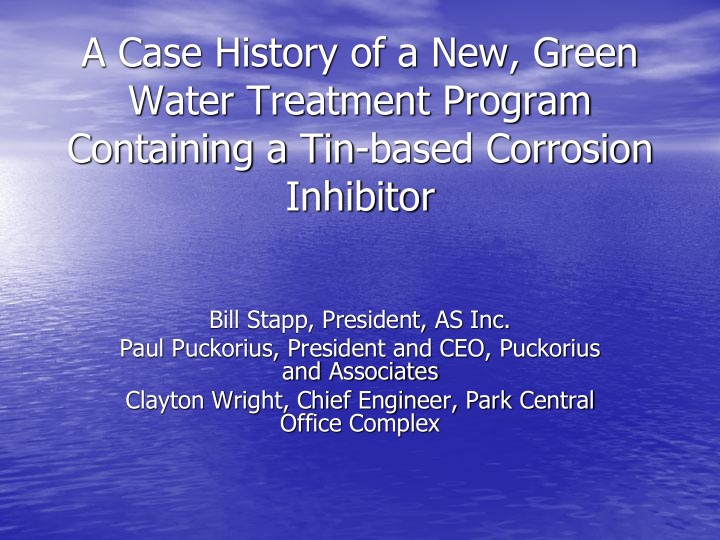



A Case History of a New, Green Water Treatment Program Containing a Tin-based Corrosion Inhibitor Bill Stapp, President, AS Inc. Paul Puckorius, President and CEO, Puckorius and Associates Clayton Wright, Chief Engineer, Park Central Office Complex
Tin Based Treatment Program • Previous laboratory evaluation by Puckorius & Associates indicated tin based water treatment program would perform well for industrial cooling water. • An opportunity to perform a field evaluation was found at the Park Central Office Complex in downtown Denver.
Tin Based Treatment Program • Park Central Office Complex is 500,000 square foot building. • AS-8310 was evaluated, Tin, Tolytriazole, HEDP, and Poly Carboxylate Polymer. • First two weeks of treatment were at twice the maintenance level of 100 PPM based on blowdown. • HVAC system was operated at 5-7 cycles of concentration.
Water Analyses HVAC at Park Central Office Complex Parameter Makeup Recirc COC Conductivity 307 1306 4.25 pH 7.2 8.45 Calcium Hardness 84 384 4.57 Chloride 5 24 4.8 M Alkalinity 56 236 4.21 Tolytriazole 0 1.9 Silica 2.8 12.5 4.46
Park Central Corrosion Coupon Data Date IN Date Out Exposed C. Steel Copper 6/2/04 9/24/04 114 0.88 0.04 9/24/04 11/3/04 40 2.01 0.07 1/5/05 5/4/05 119 0.58 0.02 8/3/05 1/4/06 154 1.47 0.02 2/15/07 3/29/07 42 0.29 0.02 3/29/07 4/27/07 29 0.651 0.155 3/29/07 5/24/07 27 0.339 0.188 5/24/07 6/28/07 35 0.35 0.15
Tin Based Treatment Program Park Central Corrosion Cupon 2.5 Tin 2 Mills Per Year 1.5 1 0.5 0 Carbon Steel Copper
Tin Based Treatment Program
Tin Based Treatment Program • How does tin work? Electron sharing. We believe the tin atom can share electrons and form a barrier that greatly reduces corrosion. • Tin also works as a reducing agent, and converts ferric (+3) iron to ferrous (+2) iron which is useful to clean up systems. • Tin concentration is determined through a tracer.
Tin Based Treatment Program • Advantages over phosphates- Phosphates require reacting with calcium to form protective layer, which can become a barrier to heat transfer. Phosphate is a nutrient. • Advantages over molybdates- Molybdates are facing increasing scrutiny. Effective doses for corrosion inhibition are 40-50 PPM. Effective doses for tin are 2-3 PPM. Molybdate has been banned in Denver.
Tin Based Treatment Program • Advantages over nitrites- Tin does not contribute a nutrient. Nitrites have been used in closed systems because the are effective as nitrites, not nitrates. Bacteria metabolize nitrites into nitrates. Thus begins the cycle of feeding biocides into the closed loop system to kill bacteria, and more nitrite to protect the system, which feeds the bacteria….
Tin Based Treatment Program • Environmental Implications- Tin is not a constituent listed on NPDES permits. • Green Technology- Using tin instead of phosphates removes a nutrient from wastewater streams. • AS-8150 and AS-8105 are NSF 60 certified, they are approved for application at levels up to 1PPM and 10 PPM respectively.
Tin Based Treatment Program • AS-8150 has been used is St. Paul, MN to reduce lead release into drinking water. • Prior to using AS-8150, St. Paul was under a mandatory lead service line replacement order. • Using AS-8150, St. Paul has passed every round of Lead and Copper sampling. • The mandatory lead service line replacement order has been rescinded and they are now on reduced monitoring status.
Tin Based Treatment Program • Stannous chloride has GRAS (generally regarded as safe) status with the USDA • Maximum approved usage is 1500 PPM as an antioxidant in canned tuna. • 20 PPM is approved for canned asparagus. • 12.5 PPM is approved for canned soda pop. • Stannous fluoride was chosen by inventors of Crest tooth paste.
Tin Based Treatment Program • Pipeloop study done by Elizabeth Esbri Amador. • Study focused on lead release as well as propensity to grow bacteria. • Lead release aspect showed PO4 to be slightly more effective. • Bacterial growth was significantly greater with PO4.
Microbiological Growth in Pipeloop Study HPC Counts 400 350 300 HPC, CFU/100 mL 250 Control 200 PO4 SnCl2 150 100 50 0 10/10/2001 10/24/2001 11/7/2001 11/21/2001 12/5/2001 12/19/2001 1/2/2002 1/16/2002 1/30/2002 2/13/2002 2/27/2002 3/13/2002 3/27/2002 4/10/2002 4/24/2002 5/8/2002 5/22/2002
Microbiological Growth in Pipeloop Study Average HPC Values 90 80 70 60 HPC CFU/100mL SnCl2 50 PO4 40 Control 30 20 10 0 Average
Conclusion • AS-8310 provides excellent mild steel corrosion control. • Tin based treatment programs can be formulated on a cost competitive basis to non tin based programs. • Heat transfer can be improved. • Microbiologically Induced Corrosion (MIC) can be significantly reduced.
Acknowledgements • Ken Allen former Chief Engineer at Park Central Office Complex • Bob Hess and Dave Puckorius of Puckorius and Associates • Ray Hozalski, PhD University of Minnesota • Elizabeth Esbri Amador Graduate Student at University of Minnesota
Recommend
More recommend